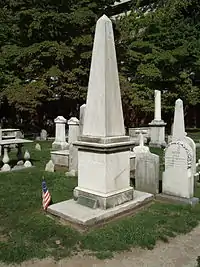Christ Church Burial Ground
Christ Church Burial Ground in Philadelphia is an important early-American cemetery. It is the final resting place of Benjamin Franklin and his wife, Deborah. Four other signers of the Declaration of Independence are buried here, Benjamin Rush, Francis Hopkinson, Joseph Hewes and George Ross. Two more signers (James Wilson and Robert Morris) are buried at Christ Church just a few blocks away.
Christ Church Burial Ground | |
 Benjamin Franklin's grave. | |
   | |
| Location | 5th and Arch Sts. Philadelphia, Pennsylvania |
|---|---|
| Coordinates | 39°57′07″N 75°08′55″W |
| NRHP reference No. | 71000062[1] |
| Added to NRHP | June 24, 1971 |
The cemetery belongs to Christ Church, the Episcopal church founded in 1695 and place of worship for many of the famous Revolutionary War participants, including George Washington. The burial ground is located at 5th and Arch Streets, across from the Visitors Center and National Constitution Center. The Burial Ground was started in 1719, and it is still an active cemetery. The Burial Ground is open to the public for a small fee, weather permitting; about 100,000 tourists visit each year. When the Burial Ground is closed, one can still view Benjamin Franklin's gravesite from the sidewalk at the corner of 5th and Arch through a set of iron rails. The bronze rails in the brick wall were added for public viewing in 1858 by parties working at the behest of the Franklin Institute, which assumed the responsibility of defending Franklin's historic ties to Philadelphia after prominent Bostonians criticized the city's maintenance of the grave and erected a Franklin statue there.[2] Leaving pennies on Franklin's grave is an old Philadelphia tradition.
Burials
Other famous people buried at Christ Church Burial Ground include:
- John Andrews, D.D., (1746-1813), 4th Provost of the University of Pennsylvania
- Michael Woolston Ash (1789–1858), congressman[3]
- Samuel John Atlee (1739–1786), delegate to the Continental Congress[3]
- Benjamin Franklin Bache (1769–1798), grandson of Benjamin Franklin, printer and publisher of the Aurora newspaper[3]
- Sarah Franklin Bache (1743–1808), daughter of Benjamin Franklin[3]
- Commodore William Bainbridge (1774–1833), Naval hero of War of 1812, captain of "Old Ironsides"[3]
- Francis Biddle (1886–1968), United States Attorney General
- James Biddle (1783–1848), Commodore in the United States Navy
- Thomas Bond (1713–1784), co-founder of Pennsylvania Hospital[3]
- Major General George Cadwalader (1806–1879), Civil War general[3]
- John Cadwalader (1805–1879), congressman and judge[4]
- Matthew Clarkson (1733–1800), mayor of Philadelphia
- Joseph Clay (1769–1811), United States Congressman
- Tench Coxe (1755–1824), Continental Congressman
- William Henry Drayton (1742-1799), Continental Congressman and a Signer of the Articles of Confederation
- John Dunlap (1747–1812), printer of the Declaration of Independence[3]
- Lewis Evans (c.1700–1756), cartographer and surveyor
- Tench Francis, Jr. (1730-1800)
- David Franks (1740–1793), aide-de-camp for General Benedict Arnold during the American War of Independence[3]
- Samuel Hardy (1758–1785), Continental Congressman
- Michael Hillegas (1729–1804), first Treasurer of the United States[3]
- Thomas Hopkinson (1709–1751), father of Francis Hopkinson, president of the Philosophical Society, one of the founders of the Library Company[3]
- John Inskeep (1757–1834), mayor of Philadelphia
- Major William Jackson (1759–1828), Revolutionary War officer, secretary of the Constitutional Convention[3]
- Thomas Lawrence, five-time mayor of Philadelphia
- Charles Mason (1728–1786), astronomer, surveyor, laid out the Mason–Dixon line in 1763[3]
- George A. McCall (1802–1868), United States Army brigadier general and prisoner of war during the American Civil War
- William M. Meredith (1799–1873), Secretary of the Treasury[3]
- Philip Syng Physick (1768–1837), known as the "Father of Modern Surgery"[3]
- John Hare Powel (1786-1856), Pennsylvania State Senator and Agriculturalist
- Samuel Powel and his wife Elizabeth Willing Powel
- Henry C. Pratt (1761–1838) prominent Philadelphia businessman and builder of Lemon Hill House.
- Matthew Pratt (1734–1805) American "Colonial Era" portrait painter.
- Benjamin Rush (1746–1813), signer of the Declaration of Independence and founder of Dickinson College, known as "The Father of American Psychiatry"[3]
- Annis Boudinot Stockton (1736–1801), poet
- Philip Syng (1703–1789), silversmith, created the Syng inkstand, early co-founder of several organizations with Benjamin Franklin[3]
- Henry Tazewell (1753–1799), U.S. Senator
- Commodore Thomas Truxtun, commander of the Constellation
- William Tuckey (1708–1781), composer
- John Goddard Watmough (1793-1861), U.S. Congressman
- Charles Willing, (1710–1754), three term Mayor of Philadelphia
- Anne Willing Francis (1733-1812) wife of Tench Francis, Daughter of Charles Willing
 Benjamin Rush's grave.
Benjamin Rush's grave. The grave of John Taylor (right), a long-time grave digger at the cemetery.
The grave of John Taylor (right), a long-time grave digger at the cemetery. Edwin De Haven headstone
Edwin De Haven headstone Commodore Bainbridge's tombstone
Commodore Bainbridge's tombstone
References
- "National Register Information System". National Register of Historic Places. National Park Service. January 23, 2007.
- "How Franklin's Grave Became a Monument and Philadelphians Were Persuaded to Like It | Hidden City Philadelphia".
- "The Graves, Christ Church, Philadelphia, official site". Archived from the original on 2011-08-11. Retrieved 2010-09-03.
- United States Congress. "John Cadwalader (id: C000011)". Biographical Directory of the United States Congress.
External links
| Wikimedia Commons has media related to Christ Church Burial Ground. |

